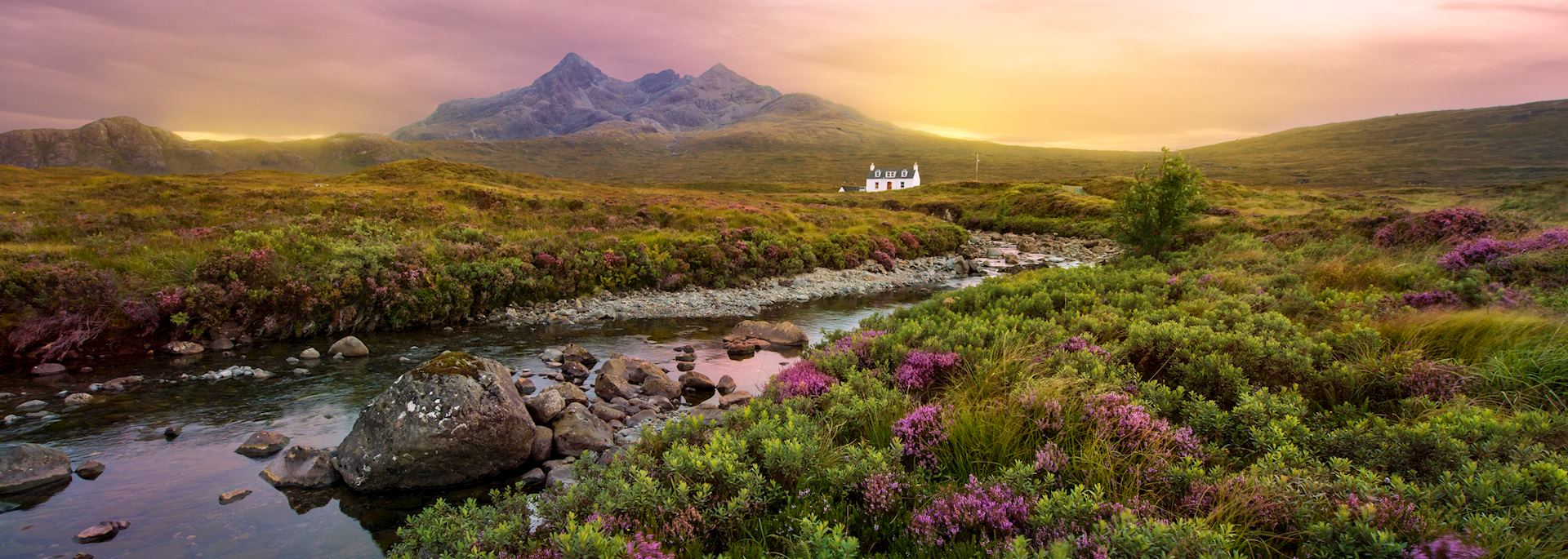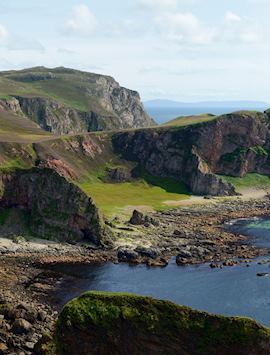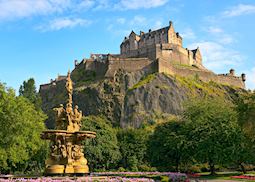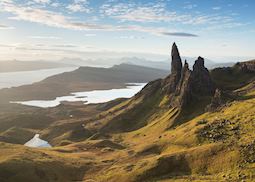The best times to visit Scotland are during spring (late March to May) and fall (September to November).
Temperatures will start to warm up in spring, ranging between 6°C and 15°C, and you may even see some sunshine. However, there will still be snow in the Highlands and the Cairngorms. If you visit in fall, temperatures will start to drop, but the russet color of the leaves is a sight to behold. There’ll be fewer crowds, too.
Scotland is at its warmest in summer, which lasts from June to August and sees temperatures of up to 19°C. The further north you go, the more daylight you’ll get.
Month-by-month guide for traveling in Scotland
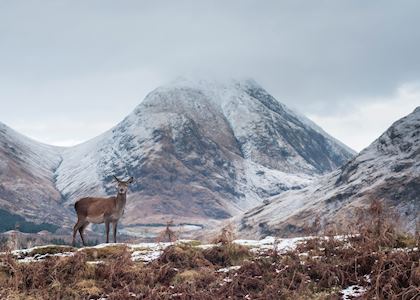
Visiting Scotland in January
January is bitterly cold in Scotland, especially in the east of the country where average temperatures hover around freezing during the daytime. Edinburgh is beset by icy winds from the coast, and much of the country is under snow, especially the mountainous areas. Hogmanay is the Scottish festival for New Year, usually marked by live music, fire dancers and fireworks. Burns Night, a celebration of national poet Robert Burns, is on the 25th of the month and is usually observed by poetry readings accompanied by whisky and haggis.
Events & Festivals
- Burns Night is a celebration of Scotland's national Poet, Robert Burns, usually celebrated with poetry readings, whisky and haggis.
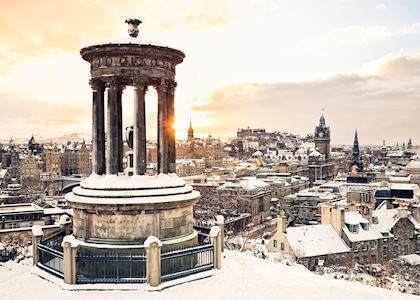
Visiting Scotland in February
February is still a cold month and receives a fair amount of snow. The Fort William Mountain Festival is held during February, celebrating all things mountainous with films, events and talks by famous mountaineers.
Events & Festivals
- The Fort William Mountain Festival is a celebration of all things mountainous, with talks by famous mountaineers, films and events.
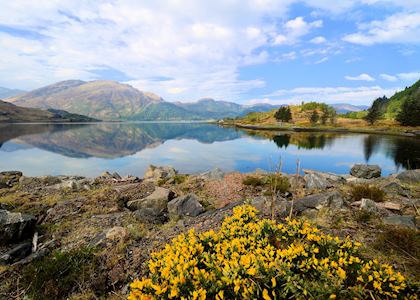
Visiting Scotland in March
In the south of the country temperatures start to rise and spring begins to emerge. In the Highlands and Cairngorms, snow remains on the mountains but the lower slopes may begin to melt.
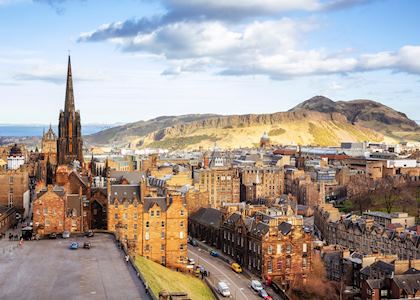
Visiting Scotland in April
Temperatures are slightly warmer, although again the mountainous areas will remain cold with snow on the peaks. This is usually when the ski areas of the West Highlands and the Cairngorms close. April is typically the driest month in Edinburgh. Beltane, a pagan fire festival, is held at the end of the month, marking the end of winter. In Edinburgh, thousands climb Calton Hill for a pagan and fire-themed performance.
Events & Festivals
- Beltane is held at the end of the month, a pagan fire festival marking the end of winter.
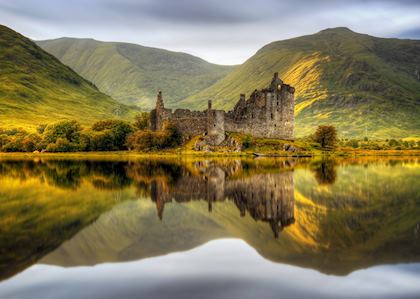
Visiting Scotland in May - June
Spring flowers and foliage really emerge in May and into June, with the snow mostly melting from all but the highest peaks. Public holidays at the beginning and end of May make these weekends particularly busy. From June, Scotland’s midges make an appearance, lasting through until the end of September. Daylight hours are long, with around 17 and a half hours by the end of June in central Scotland, increasing the further north you travel. Many Highland games are held in May and June, although these do continue through to September.
Events & Festivals
- The Highland Games feature heavy athletic events such as tossing the caber, tug-o-war as well as dance competitions and piping.

Visiting Scotland in July - August
This is peak summer in Scotland, with temperatures averaging at around 19°C. Schools break for the summer in July and this is the busiest time of year to travel. Edinburgh Festival Fringe is held throughout August, coinciding with the Edinburgh Military Tattoo, a spectacular military parade in front of the castle.
Events & Festivals
- The Highland Games feature heavy athletic events such as tossing the caber, tug-o-war as well as dance competitions and piping.
- The Edinburgh Festival Fringe is the world's largest arts festival. Held during most of August, it features all kinds of performances including comedy, dance and theater.

Visiting Scotland in September
September is the wettest month in Scotland, and temperatures decrease a little. Despite the schools returning, this is still a busy time of year to travel. The most famous of Scotland’s Highland games, the Braemar Gathering, is held in September just north of Pitlochry.
Events & Festivals
- The Highland Games feature heavy athletic events such as tossing the caber, tug-o-war as well as dance competitions and piping.
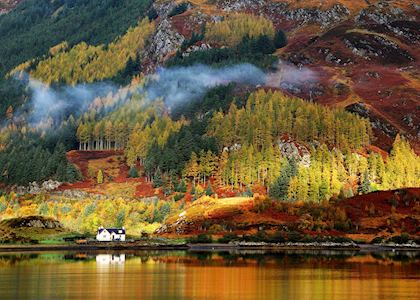
Visiting Scotland in October
Vibrant autumn foliage reaches its glorious peak toward the end of October, and the weather is typically cool and slightly drier than in September. Certain hotels and sites start to close toward the end of the month.

Visiting Scotland in November
Temperatures are fairly cold across Scotland in November, particularly in the north and the east. Autumn foliage still on the trees at the start of the month drops toward the end, and the first snowfall is often in November. This is a much quieter month to visit Scotland, although some sites may be closed. St Andrew's Day, held on the 30th of the month, is a celebration of Scotland’s patron saint, marked with feasts, music and dancing.
Events & Festivals
- St Andrew's Day is a celebration of Scotland's patron saint, marked with feasts, music and dancing, held on the 30th of the month.

Visiting Scotland in December
December has the shortest amount of daylight of the year, with long nights and cold days. It’s a relatively dry month and can see beautifully crisp, clear and sunny days.
Events & Festivals
- Hogmanay is the Scottish festival for New Year, usually marked by live music, fire dancers and fireworks.
Scotland Climate Guide
| Destination | Jan | Feb | Mar | Apr | May | Jun | Jul | Aug | Sep | Oct | Nov | Dec |
|---|---|---|---|---|---|---|---|---|---|---|---|---|
| Edinburgh | 6°C 61mm | 6°C 43mm | 9°C 51mm | 12°C 43mm | 15°C 54mm | 18°C 52mm | 19°C 63mm | 19°C 70mm | 16°C 69mm | 13°C 70mm | 9°C 68mm | 7°C 61mm |
| Fort William | 4°C 303mm | 5°C 204mm | 6°C 254mm | 10°C 127mm | 13°C 133mm | 15°C 144mm | 16°C 167mm | 16°C 189mm | 14°C 272mm | 11°C 304mm | 7°C 286mm | 5°C 299mm |
| Glencoe | 4°C 303mm | 5°C 204mm | 6°C 254mm | 10°C 127mm | 13°C 133mm | 15°C 144mm | 16°C 167mm | 16°C 189mm | 14°C 272mm | 11°C 304mm | 7°C 286mm | 5°C 299mm |
| Inverness | 5°C 71mm | 5°C 46mm | 8°C 55mm | 10°C 39mm | 14°C 51mm | 18°C 54mm | 19°C 61mm | 19°C 74mm | 15°C 72mm | 12°C 77mm | 8°C 76mm | 6°C 71mm |
| Isle of Skye | 6°C 214mm | 6°C 140mm | 7°C 173mm | 10°C 108mm | 13°C 105mm | 15°C 127mm | 16°C 144mm | 16°C 161mm | 14°C 229mm | 11°C 245mm | 8°C 248mm | 6°C 242mm |
| Loch Lomond | 5°C 225mm | 5°C 150mm | 7°C 177mm | 11°C 99mm | 14°C 119mm | 17°C 104mm | 18°C 115mm | 18°C 150mm | 15°C 206mm | 12°C 222mm | 8°C 205mm | 6°C 213mm |
Why travel with Audley?
- 100% tailor-made tours
- Fully protected travel
- Established for over 25 years
- 98% of our clients would recommend us
Travel advice
Practical tips for traveling to Scotland, from social protocols to guidance on money matters, with a link to the latest Government of Canada travel advice.

Request our brochure
Covering all seven continents, The World Your Way shows you how you can see the world with us. It features trip ideas from our specialists alongside hand-picked stays and experiences, and introduces our approach to creating meaningful travel experiences.
Trip ideas and travel guides for exploring Scotland
-
![Islay coastline]()
-
![Dunvegan Castle]()
-
Edinburgh for first-time visitors ![Edinburgh Castle]()
Edinburgh for first-time visitors
Edinburgh for first-time visitors
Read this guide -
Highlights of the Isle of Skye ![Old Man of Storr, Isle of Skye]()
Highlights of the Isle of Skye
Highlights of the Isle of Skye
Read this guide

